air condition PONTIAC GRAND PRIX 1998 Owners Manual
[x] Cancel search | Manufacturer: PONTIAC, Model Year: 1998, Model line: GRAND PRIX, Model: PONTIAC GRAND PRIX 1998Pages: 402, PDF Size: 17.96 MB
Page 140 of 402
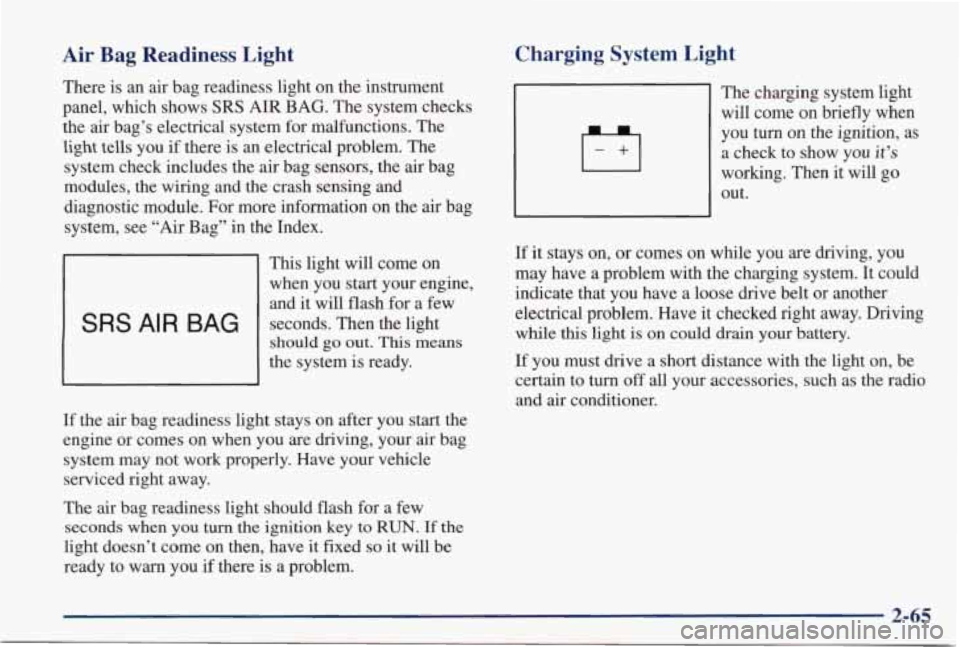
Air Bag Readiness Light
There is an air bag readiness light on the instrument
panel, which shows
SRS AIR BAG. The system checks
the air bag’s electrical system for malfunctions. The
light tells you if there is
an electrical problem. The
system check includes the
air bag sensors, the air bag
modules, the wiring and
the crash sensing and
diagnostic module. For more information
on the air bag
system, see
“Air Bag” in the Index.
This light will come on
when you start your engine,
and it will flash for a few
should go out. This means
the system is ready.
SRS AI R BAG seconds. Then the light
If the air bag readiness light stays on after you start the
engine or comes on when you are driving, your air bag
system may not work properly. Have your vehicle
serviced right away.
The air bag readiness light should flash for a few
seconds when you turn the ignition key to RUN. If the
light doesn’t come on then, have it fixed so it will be
ready to warn you if there is a problem.
Charging System Light
Ifl
The charging system light
will come on briefly when
you
turn on the ignition, as
a check to show you
it’s
working. Then it will go
out.
If it stays on, or comes on while you are driving, you
may have a problem with the charging system. It could
indicate that you have a loose
drive belt or another
electrical problem. Have it checked right away. Driving
while
this light is on could drain your battery.
If you must drive a short distance with the light on, be
certain to turn
off all your accessories, such as the radio
and air conditioner.
Page 144 of 402

The low traction light also comes on briefly when you
turn the ignition key to RUN. If the light doesn’t come
on then, have
it fixed so it will be there to tell you when
the anti-lock brake system, Traction Control System or Enhanced Traction System is active.
Malfunction Indicator Lamp
(Service Engine Soon Light)
SERVICE
ENGINE SOON
Your vehicle is equipped
with a computer which
monitors operation of the
fuel, ignition and emission
control systems.
This system is called OBD
I1 (On-Board
Diagnostics-Second Generation) and is intended to assure that emissions are at acceptable levels for the
life of the vehicle, helping to produce a cleaner
environment. The
SERVICE ENGINE SOON light
comes on to indicate that there is a problem and service is required. Malfunctions often will be indicated by the
system before any problem is apparent. This may
prevent more serious damage to your vehicle. This system is also designed to assist your service technician
in correctly diagnosing
any malfunction.
NOTICE:
If you keep driving your vehicle with this light
on, after a while, your emission controls may not
work as well, your fuel economy may not be
as
good and your engine may not run as smoothly.
This could lead to costly repairs that may not
be
covered by your warranty.
This light should come on, as a check to show you it is
working, when the ignition is on and the engine is not
running. If the light doesn’t come on, have it repaired.
This light will also come on during a malfunction in one
of two ways:
0
a
Light Flashing -- A misfire condition has been
detected.
A misfire increases vehicle emissions and
may damage the emission control system on your
vehicle. Dealer or qualified service center diagnosis
and service may be required.
Light On Steady -- An emission control system
malfunction has been detected on your vehicle.
Dealer or qualified service center
diagnosis and
service may be required.
2-69
Page 145 of 402
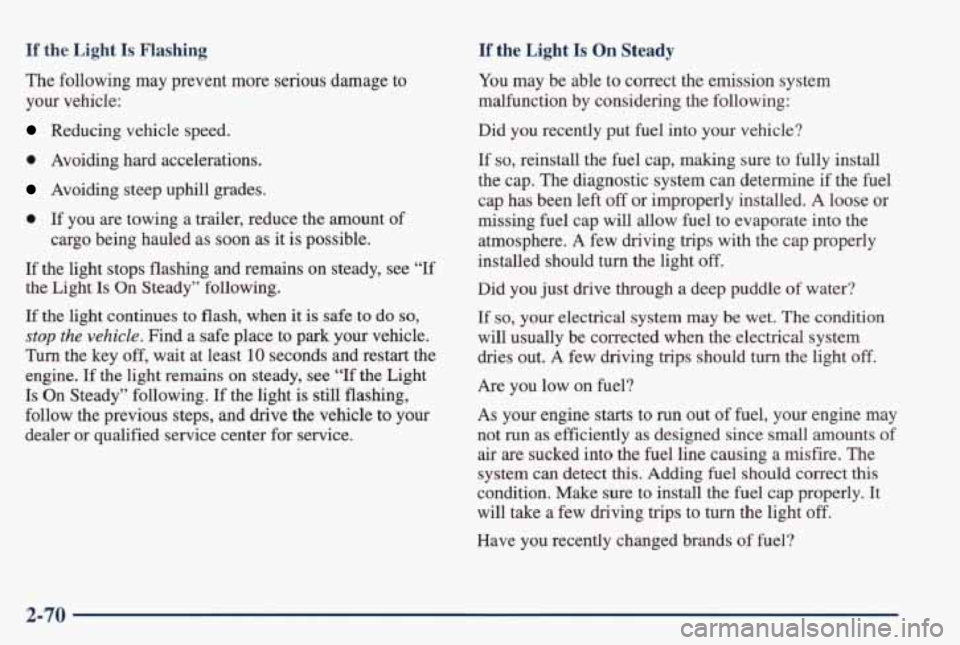
If the Light Is Flashing If the Light Is On Steady
The following may prevent more serious damage to
your vehicle:
Reducing vehicle speed.
0 Avoiding hard accelerations.
Avoiding steep uphill grades.
0 If you are towing a trailer, reduce the amount of
cargo being hauled as soon as it is possible.
If the light stops flashing and remains on steady, see “If
the Light
Is On Steady” following.
If the light continues to flash, when
it is safe to do so,
stop the vehicle. Find a safe place to park your vehicle.
Turn the key
off, wait at least 10 seconds and restart the
engine. If the light remains on steady, see “If
the Light
Is On Steady” following. If the light is still flashing,
follow the previous steps, and drive the vehicle to your dealer or qualified service center for service.
You may be able to correct the emission system
malfunction by considering the following:
Did you recently put
fuel into your vehicle?
If
so, reinstall the fuel cap, making sure to fully install
the cap. The diagnostic system
can determine if the fuel
cap has been left off or improperly installed. A loose or
missing fuel cap will allow fuel to evaporate into the
atmosphere.
A few driving trips with the cap properly
installed should
turn the light off.
Did you just drive through a deep puddle of water?
If so, your electrical system may be wet. The condition
will usually be corrected when the electrical system
dries out.
A few driving trips should turn the light off.
Are you low on fuel?
As your engine starts to run out of fuel, your engine may
not
run as efficiently as designed since small amounts of
air are sucked into the fuel line causing a misfire. The
system can detect
this. Adding fuel should correct this
condition. Make sure to install the fuel cap properly. It
will take a few driving trips to turn the light off.
Have you recently changed brands of fuel?
2-70
Page 160 of 402
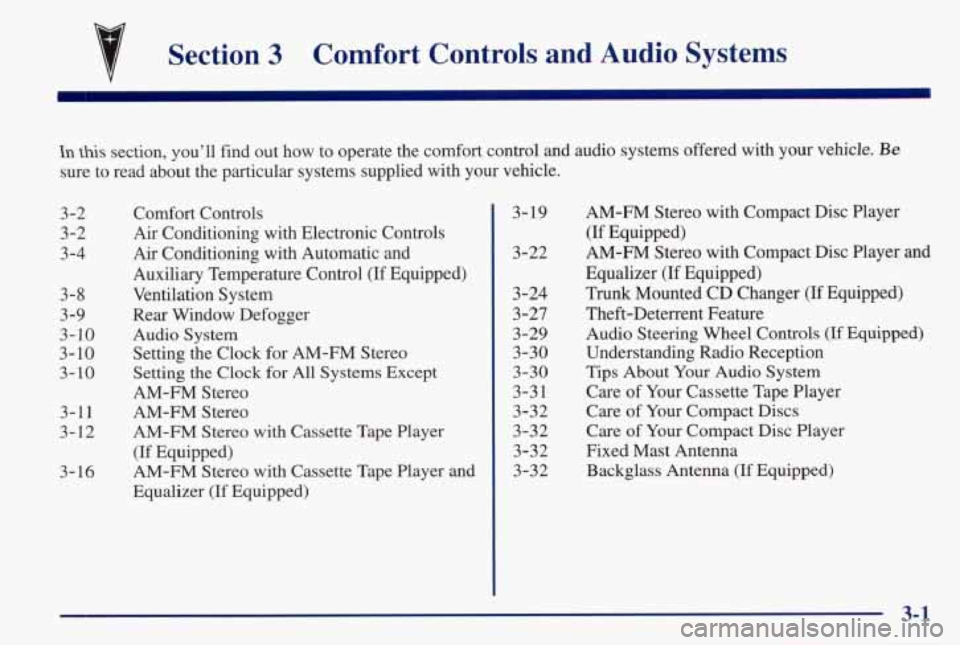
P
Section 3 Comfort Controls and Audio Systems
In this section, you’ll find out how to operate the comfort control \
and audio systems offered with your vehicle. Be
sure to read about the particular systems supplied with your v\
ehicle.
3-2
3-2
3-4
3-8
3-9
3-10
3-10
3- 10
3-1 1
3-12
3-16
Comfort Controls
Air Conditioning with Electronic Controls
Air Conditioning with Automatic and
Auxiliary Temperature Control
(If Equipped)
Ventilation System
Rear Window Defogger Audio System Setting the Clock for
AM-FM Stereo
Setting
the Clock for All Systems Except
AM-FM Stereo
AM-FM Stereo
AM-FM Stereo with Cassette Tape Player
(If Equipped)
AM-FM Stereo with Cassette Tape Player and
Equalizer (If Equipped) 3-19
3-22
3-24
3-27
3-29
3-30
3-30
3-3 1
3-32
3-32
3-32 3-32
AM-FM Stereo with Compact Disc Player
(If Equipped)
AM-FM Stereo with Compact Disc Player and
Equalizer
(If Equipped)
Trunk Mounted CD Changer (If Equipped)
Theft-Deterrent Feature
Audio Steering Wheel Controls
(If Equipped)
Understanding Radio Reception
Tips About Your Audio System
Care of
Your Cassette Tape Player
Care
of Your Compact Discs
Care
of Your Compact Disc Player
Fixed Mast Antenna
Backglass Antenna
(If Equipped)
Page 161 of 402
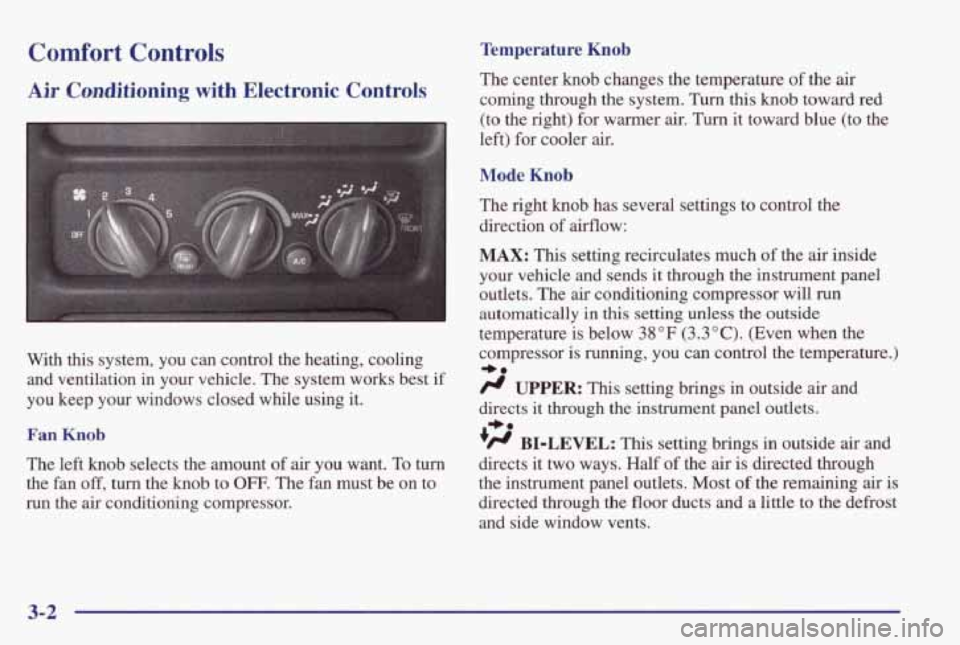
Comfort Controls
Air Conditioning with Electronic Controls
With this system, you can control the heating, cooling
and ventilation in your vehicle. The system works best if
you keep your windows closed while using it.
Fan Knob
The left knob selects the amount of air you want. To turn
the fan off, turn the knob to OFF. The fan must be on to
run the
air conditioning compressor.
Temperature Knob
The center knob changes the temperature of the air
coming through the system.
Turn this knob toward red
(to the right) for warmer
air. Turn it toward blue (to the
left) for cooler air.
Mode Knob
The right knob has several settings to control the
direction of airflow:
MAX: This setting recirculates much of the air inside
your vehicle and sends it through the instrument panel
outlets. The air conditioning compressor will
run
automatically in this setting unless the outside
temperature is below
38°F (3.3"C). (Even when the
compressor is running, you can control the temperature.)
/r UPPER: This setting brings in outside air and
directs
it through the instrument panel outlets.
'H BI-LEVEL: This setting brings in outside air and
directs it two ways. Half of the
air is directed through
the instrument panel outlets. Most
of the remaining air is
directed through the floor
ducts and a little to the defrost
and side window vents.
+e
+e
3-2
Page 162 of 402
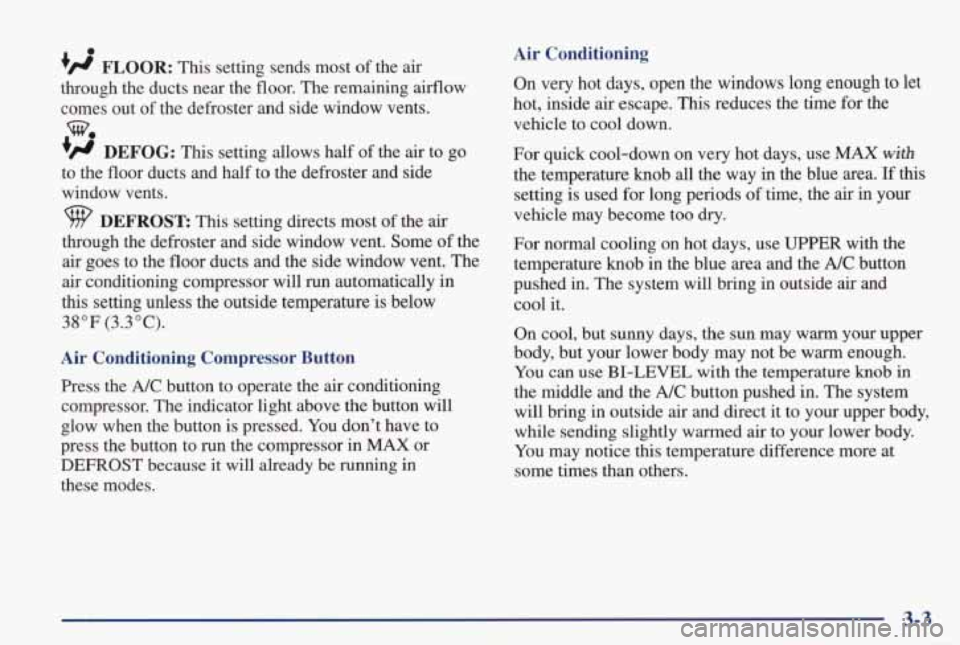
0
+# FLOOR: This setting sends most of the air
through the ducts near the floor. The remaining airflow
comes out of the defroster and side window vents.
?d DEFOG: This setting allows half of the air to go
to the floor ducts and half to the defroster and side
window vents.
w
DEFROST This setting directs most of the air
through the defroster and side window vent. Some of the
air goes to the floor ducts and the side window vent. The
air conditioning compressor will run automatically in
this setting unless the outside temperature is below
38°F (3.3"C).
Air Conditioning Compressor Button
Press the A/C button to operate the air conditioning
compressor. The indicator light above the button will
glow when the button is pressed. You don't have to
press the button to run the compressor in
MAX or
DEFROST because it will already be running in
these modes.
Air Conditioning
On very hot days, open the windows long enough to let
hot, inside
air escape. This reduces the time for the
vehicle to cool down.
For quick cool-down on very hot days, use MAX with
the temperature knob all the way in the blue area. If this
setting is used for long periods of time, the air in your
vehicle may become too
dry.
For normal cooling on hot days, use UPPER with the
temperature knob in the blue area and the A/C button
pushed in. The system will bring in outside
air and
cool it.
On cool, but sunny days, the sun may warm your upper
body, but your lower body may not be warm enough.
You can use
BI-LEVEL with the temperature knob in
the middle and the
A/C button pushed in. The system
will bring in outside air and direct it to your upper body,
while sending slightly warmed air to your lower body.
You may notice
this temperature difference more at
some times than others.
3-3
Page 163 of 402
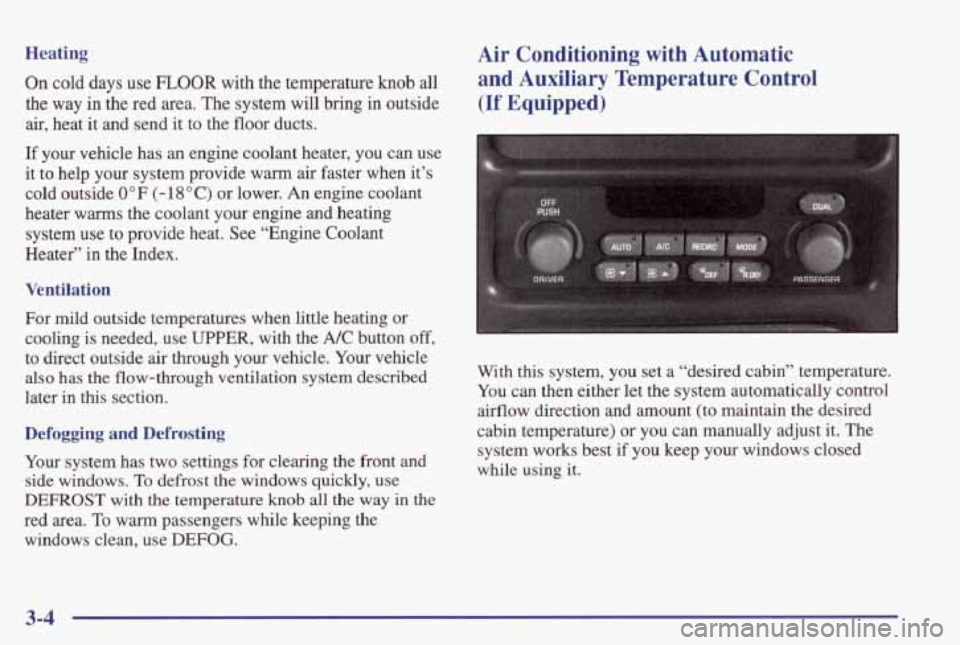
Heating
On cold days use FLOOR with the temperature knob all
the
way in the red area. The system will bring in outside
air, heat it and send it to the floor ducts.
If your vehicle has
an engine coolant heater, you can use
it to help your system provide warm
air faster when it’s
cold outside
0 OF (- 18 O C) or lower. An engine coolant
heater warms the coolant your engine and heating
system use to provide heat. See “Engine Coolant
Heater”
in the Index.
Ventilation
For mild outside temperatures when little heating or
cooling
is needed, use UPPER, with the A/C button off,
to direct outside air through your vehicle. Your vehicle
also has the flow-through ventilation system described
later in this section.
Defogging and Defrosting
Your system has two settings for clearing the front and
side windows.
To defiost the windows quickly, use
DEFROST with the temperature knob all the way in the
red area. To warm passengers while keeping the
windows clean, use
DEFOG.
Air Conditioning with Automatic
and Auxiliary Temperature Control
(If Equipped)
With this system, you set a “desired cabin” temperature.
You can then either let the system automatically control
airflow direction and amount (to maintain the desired
cabin temperature) or you can manually adjust it. The
system works best if
you keep your windows closed
while using it.
3-4
Page 164 of 402
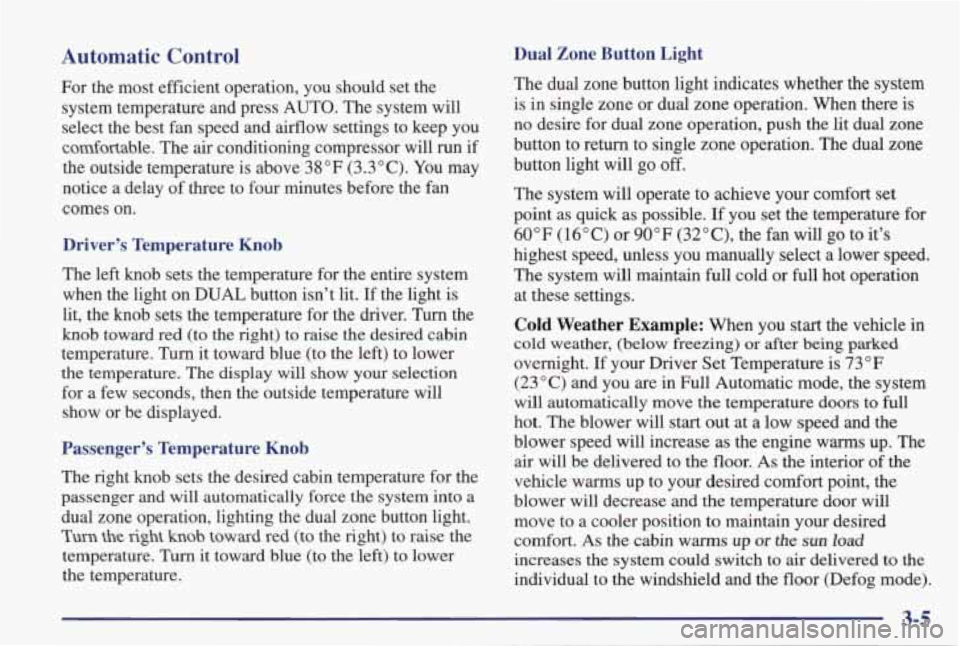
Dual Zone Button Light
The dual zone button light indicates whether the system
is in single zone or dual zone operation. When there is
no desire for dual zone operation, push the lit dual zone
button to return to single zone operation. The dual zone
button light will
go off.
The system will operate to achieve your comfort set
point as quick
as possible. If you set the temperature for
60°F (16°C) or 90°F (32"C), the fan will go to it's
highest speed, unless you manually select
a lower speed.
The system
will maintain full cold or full hot operation
at these settings.
Cold Weather Example: When you start the vehicle in
cold weather, (below freezing) or after being parked
overnight. If your Driver Set Temperature is 73°F
(23°C) and you are in Full Automatic mode, the system
will automatically move the temperature doors to
full
hot. The blower will start out at a low speed and the
blower speed will increase as the engine warms up. The
air will be delivered to the floor.
As the interior of the
vehicle warms up to your desired comfort point, the
blower
will decrease and the temperature door will
move to a cooler position to maintain your desired
comfort. As the cabin
warms up or the SUR load
increases the system could switch to air delivered to the
individual to the windshield and the floor (Defog mode).
Automatic Control
For the most efficient operation, you should set the
system temperature and press AUTO. The system will
select the best fan speed and airflow settings to keep you
comfortable. The
air conditioning compressor will run if
the outside temperature is above 38 OF (3.3 " C). You may
notice a delay of three to four minutes before the fan
comes on.
Driver's Temperature Knob
The left knob sets the temperature for the entire system
when the light on DUAL button isn't lit. If the light is
lit, the knob sets the temperature for the driver.
Turn the
knob toward red (to the right) to raise the desired cabin
temperature. Turn it toward blue (to the left) to lower
the temperature. The display
will show your selection
for a
few seconds, then the outside temperature will
show or be displayed.
.x: - J -refs Temperature Knob
The right knob sets the desired cabin temperature for the
passenger and will automatically force the system into a
dual zone operation, lighting the dual zone button light.
Turn the right knob toward red (to the right) to raise the
temperature. Turn it toward blue (to the left)
to lower
the temperature.
3-5
Page 165 of 402

Hot Weather Example: When you start the vehicle in
hot weather, 80°F (27°C) or after being parked during
the day in full sun, if your Driver Set Temperature is
73°F (23°C) and you are in Full Automatic mode, the
system will automatically move the temperature doors to
full cold. The blower will be at low speed momentarily
and then to the high speed. The
air intake will be
recirculated for maximum cooling performance. As the
interior of the vehicle cools down to your desired
comfort point, the blower will decrease and the
temperature door will move to a warmer position to maintain your desired comfort.
As the cabin cools down
or the sun load decreases the system could switch to
air
delivered to A/C vents and the floor (Bi-level mode).
Manual Control
Fan Buttons
The fan buttons select the amount of air you want when
the system is not in AUTO. The display will show the
fan speed by illuminating a maximum
of seven fan bars.
Mode Button
The center panel has several settings to control the
direction of airflow when the system is not in AUTO.
The indicator light on the button will glow when the
button
is pressed. To access the various modes available,
continue to press the MODE button until the desired
mode appears on the display.
If you prefer to manually control the heating, cooling
and ventilation
in your vehicle, push UPPER, BI-LEV,
LOWER, DEFOG or DEE AUTO will go off the
display. Set
the system to the temperature and fan speed
you want. The system will
try to maintain the
temperature you set using the mode you select.
The
following suggestions will help the system run more
efficiently in manual mode.
RECIRC: This setting recirculates much of the
air inside your vehicle and sends it through the
instrument panel outlets. The
air conditioning
compressor will run automatically in
this setting unless
the outside temperature is below 38°F (3.3"C).
Page 166 of 402
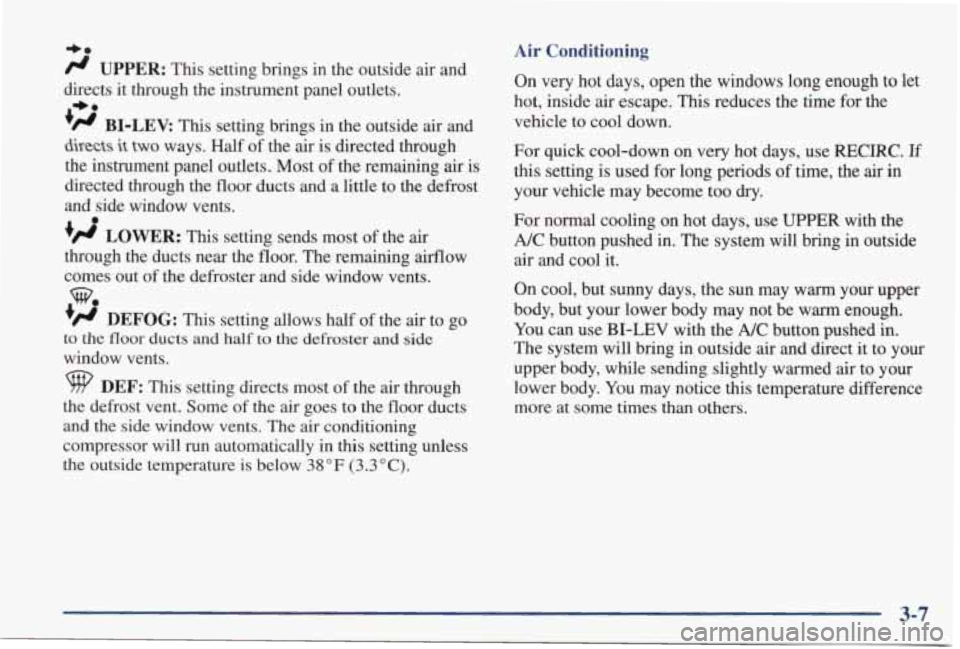
+*
/J UPPER: This setting brings in the outside air and
directs it through the instrument panel outlets.
'# BI-LEV: This setting brings in the outside air and
directs it two ways. Half of the air is directed through
the instrument panel outlets. Most of the remaining air
is
directed through the floor ducts and a little to the defrost
and side window vents.
LOWER: This setting sends most of the air
through the ducts near the floor. The remaining airflow
comes out of
the defroster and side window vents.
+e
w
DEFOG: This setting allows half of the air to go
to the floor ducts and half to the defroster and side
window vents.
DEF: This setting directs most of the air through
the defrost vent. Some of the air goes
to the floor ducts
and the side window vents. The air conditioning
compressor will
run automatically in this setting unless
the outside temperature is below 38°F (3.3"C).
Air Conditioning
On very hot days, open the windows long enough to let
hot, inside
air escape. This reduces the time for the
vehicle to cool down.
For quick cool-down on very hot days, use
RECIRC. If
this setting is used for long periods of time, the air in
your vehicle may become too
dry.
For normal cooling on hot days, use UPPER with the
A/C button pushed in. The system will bring in outside
air and cool it.
On cool, but sunny days, the sun may warm your upper
body, but
your lower body may not be warm enough.
You can use
BI-LEV with the A/C button pushed in.
The system will bring in outside air and direct it to your
upper body, while sending slightly warmed
air to your
lower body. You may notice this temperature difference
more at some times than others.
3-7